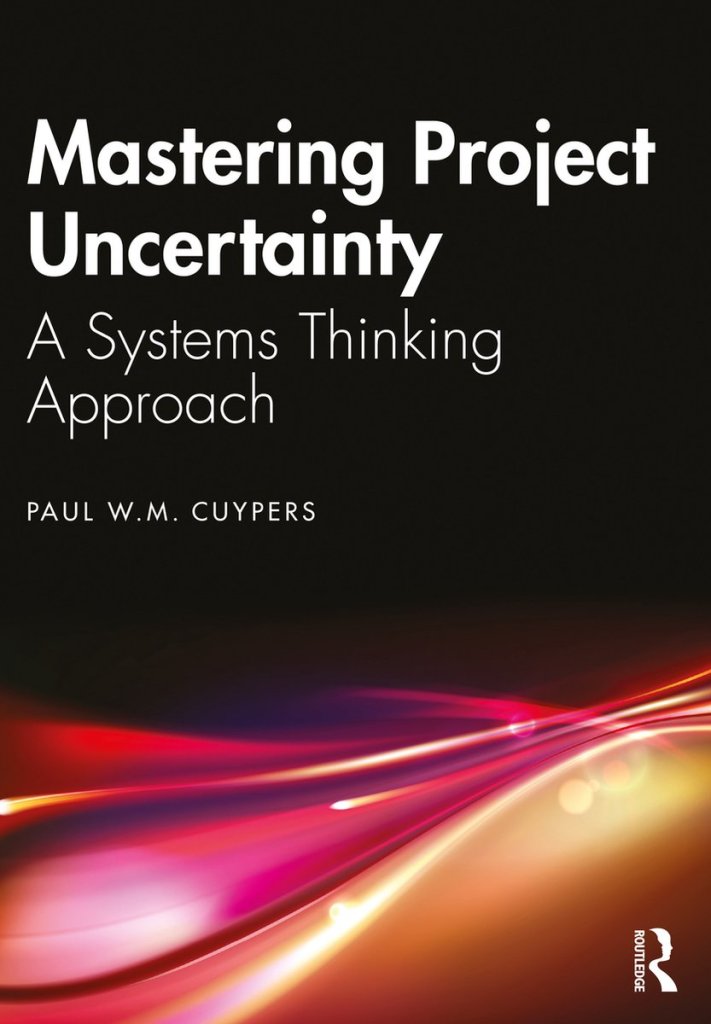
Mastering Project Uncertainty – A Systems Thinking Approach by Paul Cuypers offers a theoretical framework and practical models, tools, techniques, and guidelines to systematically minimize uncertainty, thereby increasing the chances of project success.
The book is divided in two parts. The first part offers the theoretical foundation and the second part the strategies. It starts with explanations of the relationship between the standing organization and temporary organization and why the author uses systems thinking approach to model project uncertainty.
Project uncertainty: The uncertainty matrix as a generic model to define uncertainty as a lack of information awareness or availability and a system thinking model of a project consisting of the main elements assignment, context, decisions, method, and scenarios to analyze the known-known, known-unknown, unknown-known and unknown-unknowns (the uncertainty matrix quadrants) aspects of a project. Each element will be broken down into components:
- Assignment uncertainty: Stakeholders, benefits, deliverables, activities, and resources. Possible techniques to use are project definition matrix, stakeholder mapping, player cards, benefits realization matrix, fit criterion, and budgeting.
- Context uncertainty: prerequisites, constraints, inter-dependencies, threats, and opportunities. Possible techniques to use are strategic planning, SWOT, context analysis, integrated resource planning, and business financial planning.
- Decisions uncertainty: qualifiers, alternatives, rationale, effects, confirmation. Possible techniques to use are rolling wave planning, decision trees and networks, stage gate transition, responsibility assignment matrix, and pre-mortem.
- Method uncertainty: approach, techniques, tools, communication, and coordination. Possible techniques to use are logical project control model, student-mentor relationships, one-breath challenge, switching thinking patterns, left- and right-hand questions, ground rules, and tribal spirit.
- Scenarios uncertainty: plan, risk, problem, crisis, and measures. Possible techniques to use are risk checklist, risk response routine, Ishikawa diagram, Monte Carlo simulations, and problem-solving techniques.
For each uncertainty all related components are examined, examples of implicit and explicit uncertainty are given, techniques are explained, artifact are mentioned and ends with a set of principles, concepts and questions.
The second part of the book focusses on the reduction of uncertainty (or with other words expanding the known-known quadrant in the uncertainty matrix) using the following strategies:
- Raising information awareness: step 1: create a project meta-data model, step 2: create a working log, Step 3: follow the SLACK cycle (scan, log, analyze, change, keep), and step 4: linking and filtering.
- Increasing information availability: Possible techniques to use are Ikigai-coherence, the four-phase model – strategic direction (effectiveness, efficiency, flexibility, creativity), core capabilities – project nature (R&D, innovation, transformation, operational, development, support, project), project master planning – relations, elemental value grid – value (products, services, opinions, capabilities), technology-capability matrix – technological challenge, diamond of innovation – novelty (novelty, technology, complexity, pace), Cynefin framework – domain nature (obvious, complicated, complex, chaotic, disorder), the project footprint – degree of change (organization, value chain, production systems, processes, ICT, regulatory bodies, suppliers, customers, fifth parties), VUCA grid – stakeholder attitude, budgeting – financial perspectives (business, planning, cash flow, realization), stage gate transition – conditions, strategic governance decisions – operating limits (continue as planned, re-plan, put on hold, terminate).
- Improving the effective use of information: Possible techniques to use are OODA loop (observations, orient, decisions/hypothesis, actions/tests), reviews (peer review, structured review)
- Maximizing information efficiency: Possible techniques to use are functional organization design, RACI matrix, AORA matrix (author, owner, reviewer, approver), information system design, RBAC matrix (role-based access control), and PMD matrix (project meta-data document).
Conclusion. This book shows that problems creating project failure cannot only be found and solved by risk management only. Risk is but one of many sources of problems. Mastering uncertainty by using the uncertainty matrix and a system thinking model of a project consisting of the main elements assignment, context, decisions, method, and scenarios will help to analyze the known-known, known-unknown, unknown-known and unknown-unknowns aspects of a project and helps to increase the successful delivery of the project. This book offers a fresh perspective on project management, and I highly recommend it.















